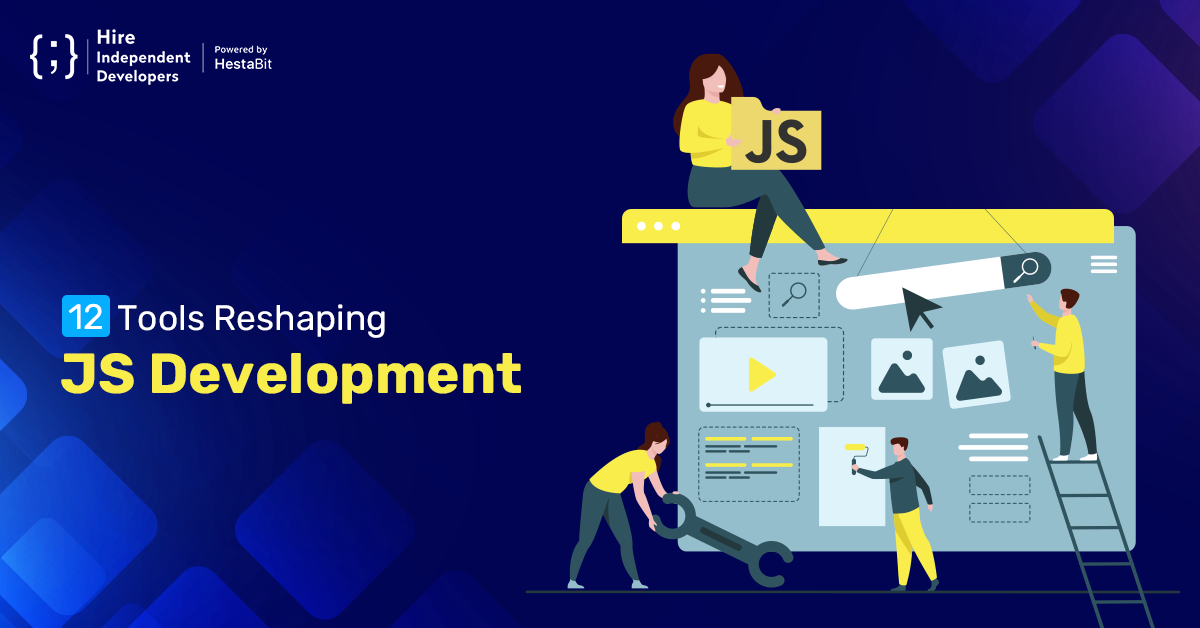When it comes to efficient programming, JavaScript needs no introduction. The popularity of JavaScript is accelerating with its top gear, and it is becoming one of the preferred choices for robust web development. You might be surprised to know that more than 97% of all websites use JavaScript as a client-side programming language. Furthermore, React, one of Facebook’s most major JS libraries, was the top-most preference of 4 out of 5 front-end developers in 2020. That’s why JavaScript development has become an excellent choice for many business owners to charge up their websites or develop interactive business applications.
However, the real power of a programming language turns up by the right tools and libraries that support, enhance, and speed up the development process. This article will discuss the top-class JavaScript tools that enhance speed, improve development experience, and produce high-quality web and mobile apps. But before that, let’s briefly talk about JavaScript development.
What is JavaScript development, and why is it on the rise?
JavaScript is a flexible, versatile, and powerful scripting and programming language that helps you implement complex features on web pages. It is one of the three core layers of web technologies (the other two being HTML and CSS). While HTML is in charge of structure and CSS for style, JavaScript offers interactivity to web pages in a web browser.
Best JavaScript tools that can change the course of web development in 2021

- ECMAScript Modules (ESM)

ECMAScript Modules or ES Modules are the official JavaScript module and the standard format to package JavaScript codes for reuse. Technically speaking, it is precisely not a JS tool. However, it has a close connection with JavaScript tools. For a while, we have been witnessing an emergence of havoc and uncertainty in JS module usage (such as NodeJS landing on the commonJS syntax). However, with the recent ESM approval and its general execution in the web browsers, new possibilities are getting their way.
You can see the general form of ESM syntax below in Listing 1. The first line shows the syntax for importing a default export. The second one uses destructuring to describe the members inside the module.
Listing 1: ESM Syntax
import aModule from ‘module-name’;
import { moduleMember, anotherMember } from ‘module-name’;
You can use modules in two ways; either in the JS scripts, it comprises, or directly in the unique ‘module’ script tag, shown below in Listing 2.
Listing 2: Importing via Script module
<script type=”module” src=”https://unpkg.com/browse/[email protected]/“></script>
<script type=”module”>
import React from ‘react’;
</script>
<script type=”module” src=”../my-module.js”></script>
The first two script tags represent how to target an absolute URL. We have used the ‘SRC’ attribute in the first instance and executed the JavaScript import in the second.
The third script tag represents a relative import supplied from the same domain.
- ESbuild

ESbuild is one of the recent entries in the bundler field. Like many other bundlers, it claims to fame for its functioning and speed. Opposed to JavaScript, ESbuild uses Go to benefit from Go’s in-built parallelism. It also depends on intelligent shared memory usage during syntax analysis and code construction.
If you want to get an insight into the speed of ESbuild, you can take a look at the project’s benchmarks. It will show you the outstanding performance of ESbuild over other bundlers that extends to 100x.
ESbuild is suitable for bundling browsers. However, as per its properties, you can also use it to bundle NodeJS. It offers a JavaScript API to roll up build commands when your requirements become too complex and cumbersome for command-line use. Below is an example to show you how to use this API:
Listing 3: Using the ESbuild JS API
require(‘esbuild’).build({
entryPoints: [‘app.jsx’],
bundle: true,
outfile: ‘out.js’,
}).catch(() => process.exit(1))
Currently, ESbuild has around 27.2K GitHub stars and over 580K weekly NPM downloads.
- ESLint

Linting is one of the crucial things that can not be ignored while coding for a website or application software, and ESLint is one of the ace tools to do this. Linting means analyzing the code for possible errors. ESLint is a perfect program for this task because you do not need to execute the code for identifying the problematic code, and it saves time to a large extent.
One of the important things that attract developers is its configurable linting rules with which you can quickly configure code or pattern guidelines that ESLint will analyze. Here is an example of how to use ESLint for linting the code:
{
“plugins”: [
“react”
],
“extends”: [
“eslint:recommended”,
“plugin:react/recommended”
],
“rules”: {
“react/no-set-state”: “off”
}
}
- Parcel

It would be negligent not to mention Parcel, which is a tool similar to Rollup and Webpack. The best thing about Parcel is that it requires no or minimal configurations to perform.
Hot Module Replacement (HMR) and no-config code-splitting are some out-of-the-box features that make Parcel a must-use tool. With Parcel, you can also integrate many file types (like images, graphics, etc.) by default and manage them without any additional configurations. In addition to lowering configurations, this tool also claims to enhance the performance of your web app.
Parcel has over 40K stars on GitHub and around 286Kmonthly downloads that can quickly help you form an opinion about the popularity of this tool.
- Pnpm

Pnpm is not just a development tool. Instead, it acts as a replacement for the npm dependency tool. Although this tool is somewhat similar to Yarn – a JS package manager for your code, it takes a slightly different approach.
Pnpm utilizes hard links to flatten the node_modules tree, which assists you in simplifying the dependency management and preventing you from getting duplicate dependencies. It helps in saving much of the system’s storage space.
Pnpm uses pnpx, (a tool similar to npx) for implementing and running packages. It has over 12.5K GitHub stars and around 195K weekly NPM downloads. Its unique approach and qualities make it one of the best dependency package managers in the town. Along with all this, Pnpm also outperforms many other package managers in terms of performance and speed.
- Rollup

When you desire to use ESM syntax everywhere, Rollup is the tool you should head over to. It is a bundler that streamlines over the various syntaxes available out there, such as CJS, EMS, UMD, AMD, etc., and bundles your code into the one that works just fine.
One of the best features of Rollup is ‘tree-shaking,’ which involves analyzing your codebase and removing unused imports. It significantly impacts and enhances the performance of your program.
Rollup ties into package.json and node_modules through NPM, similarly to ESbuild and other bundlers. While using this tool, you can forget about module syntax and access ESM. It focuses on offering you the experience of future JavaScript development when everything is consolidated on ESM.
In terms of operations, it operates similarly to Webpack. However, the significant difference between the two is that Rollup supports NodeJS output, but Webpack does not.
As per the current report, Rollup has 20.6K GitHub stars and over 5 million weekly NPM downloads.
- Vite

Initially developed as a build tool for Vue, developers can now use Vite for general purposes too. It has appeared as the official development solution for SvelteKit, which has raised its popularity level to a more significant extent.
As a JS development tool, Vite primarily focuses on two requirements: developing for production and running dev mode. It is not related to bundling, and in fact, it hands over its bundling tasks to Rollup.
You might not be aware, but Vite in French means ‘fast,’ and it acts the same way that its name suggests. In fact, many users claim that it is pretty fast compared to Webpack or other similar tools. It is one of the prominent JavaScript tools, and one can improve its performance by using ESbuild and leveraging ESM for pre-building. The benefit of using ESM is that it offloads bundling to the browser during the web app creation and determines which files need to be served during the modifications.
The most vital selling point of Vite is its quick HMR. As of May 2021, it has over 27K GitHub Stars and more than 125K weekly NPm downloads.
- Snowpack

Snowpack is another bundler and dev server in the list known for its speed and efficiency. The key features that make it one of the prevalent JavaScript tools include ESM support with smart caching, quick HMR, fast server start time, and low config support to different file types.
In terms of working, Snowpack is similar to Parcel and Rollup. It supports targeted HMR for JavaScript and CSS modules. One of the best things about this tool is that a robust plug-in community backs it up. Currently, it has more than 19K GitHub stars and over 60K weekly NPM downloads.
- Babylon.js

Developing web pages and web applications is okay, but what if someone wants to develop creative browser games? Well, if you are that someone, then Babylon.js is the solution you are looking for.
Babylon.js is a robust framework that supports HTML5, WebGL and Web audio. Along with this, you can also accomplish complicated tasks using this tool, such as drawing 3-dimensional objects in pure WebGL with reduced codes and programming.
If you want to develop an interactive 3-D browser game like Shell Shockers without getting into Unity 3D or C# programming, Babylon.js is the perfect choice you can go with.
One point you should take note of is that Babylon.js is typically used for building 3-D browser games. However, if you are a JS beginner and want to get your hands on 2-D games first, you can go with the 2-D brother of Babylon.js – Phaser.js! With it, you can easily develop artistic and interactive two-dimensional games, such as Short Life.
- Crafty

Crafty is another widely used game-building solution available for you, especially when you want to create a gaming web app from a list of components. It is one of the prevalent JavaScript tools based on entities, elements and features as building blocks. These components are just pre-built code blocks that can be any gaming elements like game terrain, buttons, graphics, sound, etc.
Although using Crafty is not that straightforward, once you get your hands on this tool, you can quickly write your own components and do wonders!
- PhoneGap/Cordova

PhoneGap is one of the most popular app development frameworks to create top-quality hybrid mobile applications. One of the most common usages of this framework is to package a website into an Android.APK file. With this, you can launch it as a native Android app inside a web wrapper, including JS, HTML5, and CSS effects distinctive to the hybrid apps. It means that the apps developed with PhoneGap deliver such a fantastic native user experience that users could not believe they are accessing a hybrid or cross-platform app.
Currently, there are over 59 thousand apps built using PhoneGap with more than 9 billion downloads.
- jQuery Mobile

In the old times, developing a simple image mouseover app required massive lines of code, and even that was platform-dependent. But things became better when the jQuery team launched jQuery Mobile in 2010, enabling users to build high-class and stunning JavaScript applications compatible with multiple platforms.
jQuery Mobile is a top-rated, touch-optimized web (and mobile) framework used to develop brilliant applications. It can leverage the functionalities of HTML5, jQuery, and CSS3 along with jQuery UI into a unified framework. With this, the developers can easily achieve consistency and code stability across different platforms and devices.
The Future of JavaScrip Development Tools
Undoubtedly, there are many JS tools available in the market which have been in use for a long time. However, with the transforming technologies and advanced requirements, you might require more functional tools that meet the current standards. Newer JavaScript tools come with a unique landscape to offer you enhanced performance and a better developer experience while developing an app. The more functionalities developers get while building a web app, the more interactive they will conceive it. Consequently, better will be the user experience and more significant will be the profit for your business.





